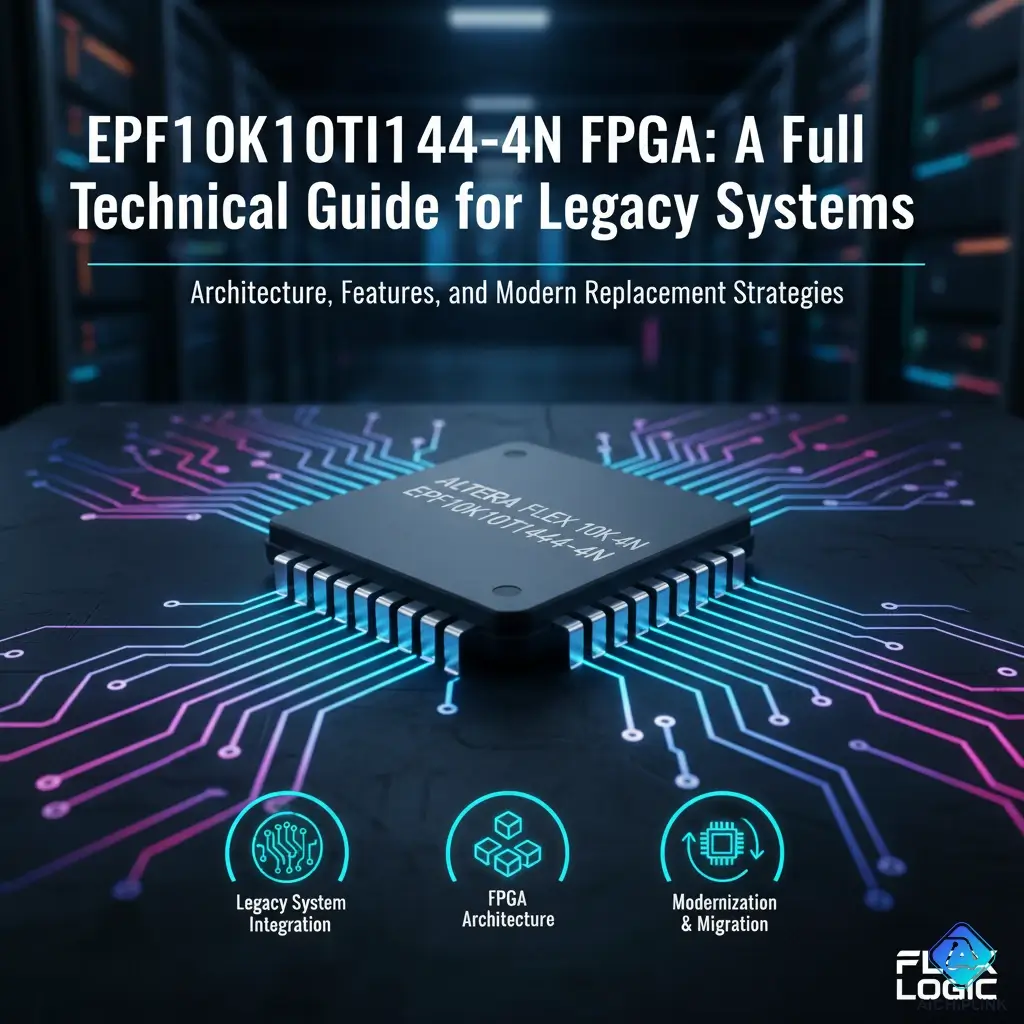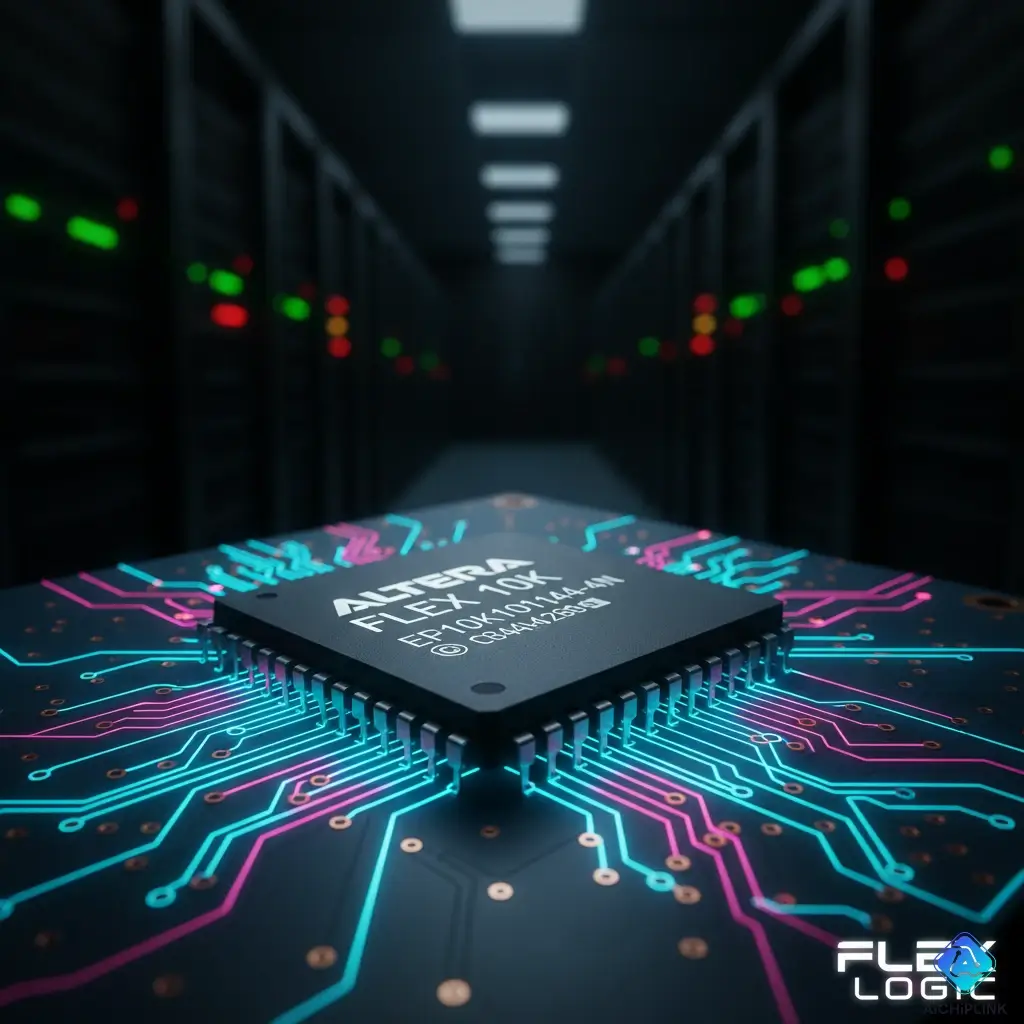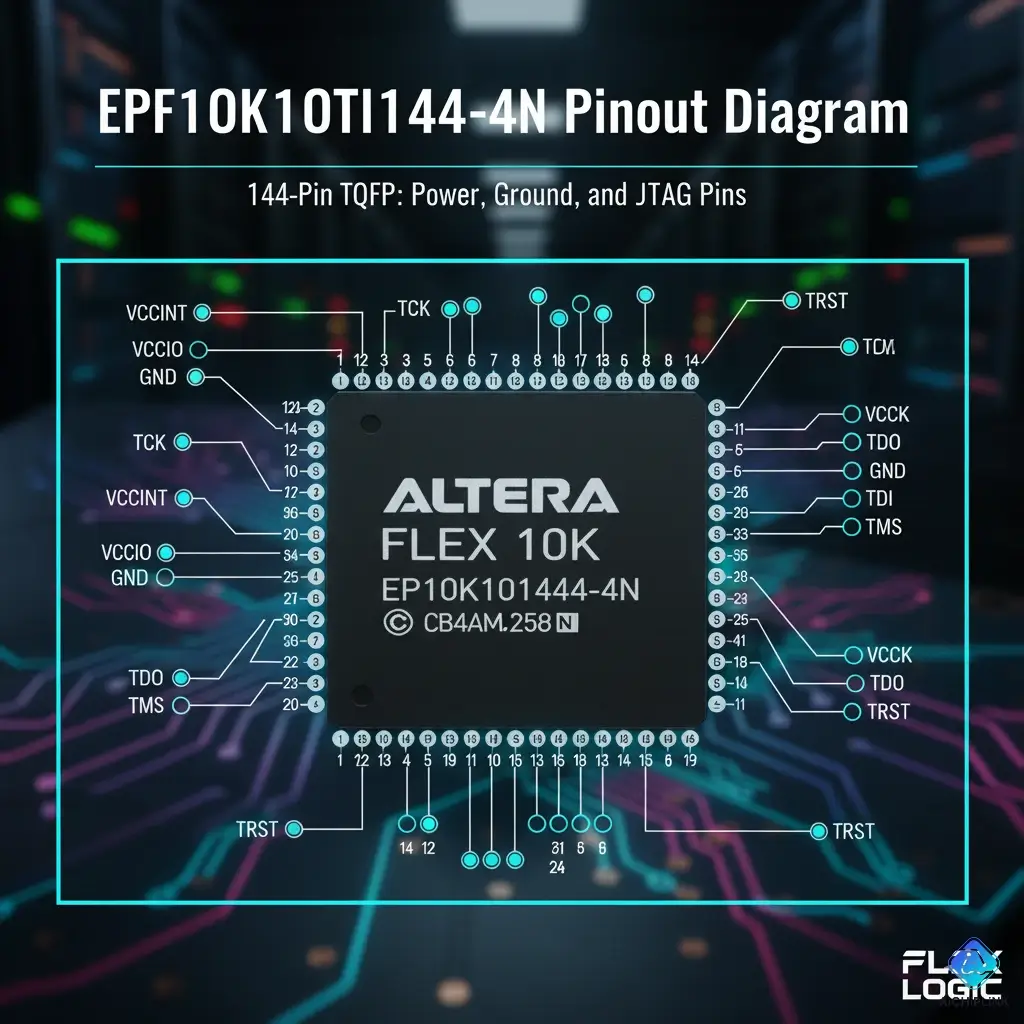
Table of Contents
- 1.0 What is the EPF10K10TI144-4N? (Datasheet Explained)
- 1.1 An Overview of the Altera FLEX 10K Family
- 1.2 Decoding the Part Number: EPF10K10TI144-4N
- 1.3 Obsolescence Status: A Critical Component for MRO
- 2.0 EPF10K10TI144-4N Key Technical Specifications
- 2.1 Core Logic, Memory, and I/O Specs
- 2.2 Operating Voltage and Temperature
- 3.0 EPF10K10TI144-4N Pinout (TQFP-144 Package)
- 3.1 144-Pin TQFP Package Diagram
- 3.2 Key Pin Functions: Power, JTAG, and Configuration
- 4.0 How to Program the EPF10K10TI144-4N
- 4.1 The Correct Software: Legacy Altera Quartus II
- 4.2 SRAM Configuration and Booting
- 4.3 EPF10K10TI144-4N vs. Modern FPGAs
- 5.0 Common Applications and Use Cases
- 5.1 Where You'll Find This Legacy FPGA
- 6.0 Frequently Asked Questions (FAQ)
If you're an engineer working on industrial control systems, medical equipment, or long-life telecommunications gear, you've probably encountered this part number: EPF10K10TI144-4N. While modern FPGAs are built on cutting-edge 7nm processes, this 5V workhorse from the 1990s is a critical component that keeps billions of dollars worth of legacy equipment running.
In fact, the market for "obsolete" electronic components is a vital segment of the industry, with a 2023 report highlighting that MRO (Maintenance, Repair, and Operations) budgets are increasing as companies extend the life of their proven systems.
You're here because you need to service, replace, or understand this specific device. This isn't a "new design" part; it's a "keep the line running" part. This guide is your technical deep dive, providing the essential EPF10K10TI144-4N datasheet information, pinout, and programming requirements you need to get the job done.
1.0 What is the EPF10K10TI144-4N? (Datasheet Explained)
The EPF10K10TI144-4N is a 5-volt, SRAM-based Field-Programmable Gate Array (FPGA) from the Altera FLEX 10K family. This device was one of the first in the industry to offer a "System-on-a-Programmable-Chip" (SOPC) solution by embedding blocks of memory (EABs) alongside traditional logic (LABs).
1.1 An Overview of the Altera FLEX 10K Family
The Altera FLEX 10K family was a game-changer. It was the first PLD (Programmable Logic Device) to integrate both logic and memory in a flexible "embedded array."
- Logic Array Blocks (LABs): These are the core of the FPGA, containing 8 Logic Elements (LEs) each, which are used to implement your VHDL or Verilog code.
- Embedded Array Blocks (EABs): This was the big innovation. Each EAB is a 2,048-bit block of RAM. This allows for efficient on-chip data buffering, FIFOs, or small processor memory without using up valuable logic cells.
1.2 Decoding the Part Number: EPF10K10TI144-4N
The part number tells you everything you need to know:
- EPF10K10: The device family (FLEX 10K) and density (10,000 typical gates).
- T: Denotes the package type, TQFP (Thin Quad Flat Pack).
- I: Indicates the Industrial temperature range.
- 144: The pin count, 144 pins.
- -4: The speed grade. A
-4is one of the standard speed grades for this family. - N: Indicates the device is lead-free (RoHS compliant).
1.3 Obsolescence Status: A Critical Component for MRO
This is the most important takeaway: The EPF10K10TI144-4N and the entire FLEX 10K family are obsolete (End-of-Life). They are no longer manufactured by Intel (who acquired Altera) and are Not Recommended for New Designs (NRND).
Their value today is exclusively as MRO (Maintenance, Repair, and Operations) and replacement parts for existing systems. Because these devices are no longer in production, sourcing is the number one challenge. You must find a reliable distributor of genuine obsolete FPGAs to avoid costly counterfeit parts.

2.0 EPF10K10TI144-4N Key Technical Specifications
When you're replacing a part, you need to match the specs exactly. Here is the core datasheet information for the EPF10K10TI144-4N.
2.1 Core Logic, Memory, and I/O Specs
| Feature | Specification |
|---|---|
| Family | FLEX 10K |
| Logic Elements (LEs) | 576 |
| Logic Array Blocks (LABs) | 72 |
| Typical Logic Gates | 10,000 |
| Total RAM Bits | 6,144 bits (3 x EABs of 2,048) |
| Max User I/O Pins | 102 |
| Technology | SRAM-based (volatile) |
| Package | 144-Pin TQFP |
2.2 Operating Voltage and Temperature
- Core Supply Voltage (VCCINT): 5.0V (Typical 4.75V to 5.25V)
- I/O Supply Voltage (VCCIO): 5.0V (interfaces with 5V logic)
- Temperature Grade: Industrial (-40°C to 85°C)
The 5V operation is a defining feature. This part was designed to work directly in 5V TTL logic systems, which were the standard for industrial controls for decades.
3.0 EPF10K10TI144-4N Pinout (TQFP-144 Package)
When you're troubleshooting a board, you need the pinout. The EPF10K10TI144-4N uses a 144-pin Thin Quad Flat Pack (TQFP), which has 36 pins per side.
3.1 144-Pin TQFP Package Diagram

3.2 Key Pin Functions: Power, JTAG, and Configuration
While you need the full datasheet for a complete pin list, here are the pins you must check when troubleshooting:
- Power (VCCINT & VCCIO): These are the 5V supply pins. The device has multiple VCCINT and VCCIO pins, and all must be connected.
- Ground (GND): All GND pins must have a solid connection to the ground plane.
- JTAG Pins (TDI, TDO, TCK, TMS): These are the Joint Test Action Group pins. They are essential for programming the device and for boundary-scan testing. If a board is dead, these are the first pins to check for activity.
- Configuration Pins (MSEL0, MSEL1): These pins are hard-wired on the PCB to tell the FPGA how to load its configuration (e.g., from a serial PROM).
- Configuration EPROM Pins (DATA0, DCLK): If the board uses a serial EPROM (like an EPC1), these pins load the configuration data into the FPGA at power-on.
4.0 How to Program the EPF10K10TI144-4N
This is the most critical hurdle for engineers working with legacy parts. You cannot use modern Intel Quartus Prime software.
4.1 The Correct Software: Legacy Altera Quartus II
To program or even just test an EPF10K10TI144-4N, you must use a compatible legacy software version.
- Required Software: Altera Quartus II (e.g., Version 9.0 or earlier) or the even older MAX+PLUS II software.
- Why? Modern software (Quartus Prime) has completely dropped support for the old FLEX 10K device family. The new compilers do not know how to generate a bitstream for this chip.
- OS Compatibility: You will likely need to run this legacy software on an older operating system, such as Windows XP or Windows 7 (32-bit), in a virtual machine.
4.2 SRAM Configuration and Booting
The EPF10K10TI144-4N is SRAM-based, which means its configuration is volatile (it's erased when power is lost).
- At Power-On: The device wakes up blank.
- It needs to be configured by loading a "bitstream" (a
.sofor.poffile). - This is usually done by a small, non-volatile serial configuration EPROM (like an Altera EPC1 or EPC1441) that sits next to the FPGA on the PCB. The FPGA automatically reads from this PROM at boot.
- Alternatively, a microcontroller can load the configuration file onto the FPGA using the JTAG port.
4.3 EPF10K10TI144-4N vs. Modern FPGAs
If you are ever forced to redesign a board, it's helpful to see how far technology has come.
| Feature | EPF10K10TI144-4N (Legacy) | A Modern FPGA (e.g., Cyclone 10 LP) |
|---|---|---|
| Supply Voltage | 5.0V | 1.2V Core |
| Logic Elements (LEs) | 576 | 10,000+ |
| RAM | 6 kbit | 400 kbit+ |
| Max Frequency | ~125 MHz | 400 MHz+ |
| Software | Quartus II (Legacy) | Quartus Prime (Modern) |
5.0 Common Applications and Use Cases
5.1 Where You'll Find This Legacy FPGA
The EPF10K10TI144-4N was the "brains" for thousands of products. You will most commonly find it performing these roles in legacy equipment:
- System "Glue Logic": Connecting a CPU to its RAM, peripherals, and I/O.
- Bus Interfacing: Acting as a bridge between two different bus standards (e.g., ISA to a custom proprietary bus).
- Digital Signal Processing (DSP): The EABs made it suitable for simple, parallel DSP tasks like filters (FIR) or correlators.
- Industrial Control: Running the state machines for PLCs, motor drivers, and robotics.
- Telecommunications: Used in line cards and switching fabrics.
Conclusion: A Critical Legacy Workhorse
The EPF10K10TI144-4N represents a pivotal moment in programmable logic history, bridging the gap between simple CPLDs and modern FPGAs. While it is long past its prime for new designs, it remains a critical and sought-after component for maintaining the world's industrial, medical, and telecommunications infrastructure.
Working with this device requires specific legacy knowledge, software, and a trusted supply chain partner. If you are in the challenging position of needing to source this or other obsolete FPGAs, you cannot risk line-down situations with unverified parts.
Contact AichipLink today. We are experts in the global sourcing of obsolete and hard-to-find components, and we can help you secure the EPF10K10TI144-4N parts you need to keep your legacy systems operational.

Written by Jack Elliott from AIChipLink.
AIChipLink, one of the fastest-growing global independent electronic components distributors in the world, offers millions of products from thousands of manufacturers, and many of our in-stock parts is available to ship same day.
We mainly source and distribute integrated circuit (IC) products of brands such as Broadcom, Microchip, Texas Instruments, Infineon, NXP, Analog Devices, Qualcomm, Intel, etc., which are widely used in communication & network, telecom, industrial control, new energy and automotive electronics.
Empowered by AI, Linked to the Future. Get started on AIChipLink.com and submit your RFQ online today!
Frequently Asked Questions
What is the EPF10K10TI144-4N?
The EPF10K10TI144-4N is a legacy 5V Field-Programmable Gate Array (FPGA) from the Altera FLEX 10K family. It features 10,000 typical gates (576 Logic Elements), 6,144 bits of RAM, and 102 user I/O pins in a 144-pin TQFP package. It has an industrial temperature rating.
Is the EPF10K10TI144-4N obsolete?
Yes, the EPF10K10TI144-4N and the entire Altera FLEX 10K family are considered **obsolete (End-of-Life)** and are not recommended for new designs. They are primarily sourced for the maintenance, repair, and operation (MRO) of existing legacy equipment.
What software is used to program the EPF10K10TI144-4N?
You must use a legacy version of the **Altera Quartus II** development software (e.g., v9.0 or earlier) or the even older **MAX+PLUS II** software. Modern Intel Quartus Prime does not support the FLEX 10K family.
What is the difference between an FPGA and a CPLD?
The FPGA (Field-Programmable Gate Array) like the FLEX 10K is typically SRAM-based (volatile), has a high density of small logic "cells," and includes dedicated RAM blocks. A CPLD (Complex Programmable Logic Device) is typically non-volatile (keeps its program) and has a more rigid logic structure, making it better for simple logic and faster, more predictable timing.
What is a replacement for the EPF10K10TI144-4N?
There is **no direct, pin-for-pin replacement** for this device. For repair and maintenance, you must source an identical **EPF10K10TI144-4N**. For a new design, you would need to re-engineer the entire board to use a modern, low-voltage FPGA (like an Intel Cyclone 10 LP or AMD Spartan-7).









